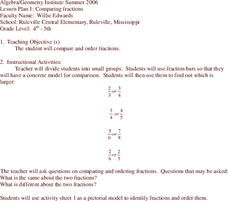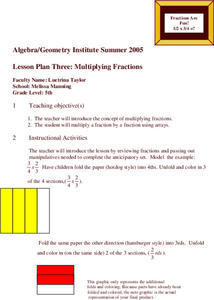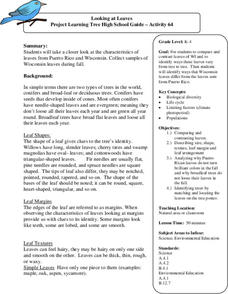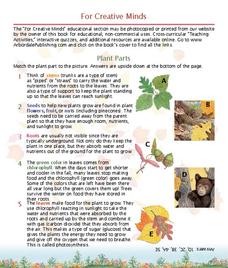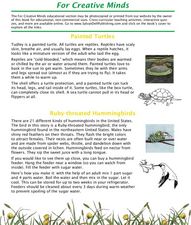Curated OER
Polygon Necklaces
Students explore geometry by creating jewelry in class. In this polygons lesson, students identify different shapes and characteristics while creating polygon figures from construction paper. Students utilize a multitude of shapes...
Curated OER
Natural Records of Change: Working with Indirect Evidence of Past Climates
Students take part in a dice game to better explain the differences between direct and indirect evidence. They apply this knowledge to how scientists have used both types of evidence to determine how climate has changed over time.
Curated OER
Remote Sensing and the Electromagnetitc Spectrum
Fifth graders conclude that each color of the spectrum has a different amount of thermal energy by measuring temperature with a thermometer. They infer that there is an invisible band of the spectrum by measuring temperature beyond the...
Curated OER
Thanksgiving Turkey Napkin Holder
Studens create turkey napkin holders. They discuss how Thanksgiving originated and why we celebrate this holiday. They create their napkin holders using craft sticks, glue guns, construction paper, feathers, and glitter.
Curated OER
Comparing Fractions
Learners investigate concepts of working with fractions. They compare different fractions and put them in chronological order. The quantities are compared as either being larger or smaller also.
Curated OER
Multiplying Fractions
Fifth graders explore the multiplication of fractions. Using paper folds, 5th graders observe multiplying by a fraction. They extrapolate multiplication problems from studying a written graphic.
Curated OER
Solving One-Step Equations
Ninth graders explore the concept of a simple equation. They use addition and subtraction in one step in order to find balance to both sides of the equation. Students are encouraged to succeed using positive praise at the beginning of...
Curated OER
Looking At Leaves
Learners investigate the different leaves of Wisconsin. They gather samples of leaves in order to compare to the samples taken from Puerto Rico. They make observations and collect data recording the size, shape, and texture of the...
Curated OER
Adjectives
Students are encouraged to think about the adjectives they choose and to steer away from adjectives that have become meaningless through overuse, such as "nice" and "good." They then add meaning and interest to sentences.
Curated OER
Solstice and Equinox
Students identify the dates of the solstices and equinoxes and how they relate to the various seasons on Earth. After discussing how the solstice and equinox affect the seasons, students use their bodies to demonstrate the how each...
Curated OER
Sonar Simulation
Learners explore how a side-scan sonar can help locate underwater objects. In this hands- on lesson students compare side-scan sonar and other methods used to search for underwater objects by creating their own "simulation" of a...
Curated OER
Animal Camouflage
Students investigate how animals adapt to their environment. In this animal science lesson, students participate in an experiment using patterned paper and plain paper to simulate how animals blend into their surroundings. Students...
Curated OER
Plant Parts
Students recognize the parts of the plant and the function it provides.In this plant parts lesson, students participate in three activities relating to plant parts and properties.
Curated OER
Camouflage, Protection, & Adaptations—Who am I?
Students explore ocean animal adaptations. In this animal adaptations lesson, students examine how different ocean animals use adaptations other than camouflage to protect themselves.
Curated OER
For Creative Minds: Tudley Didn't Know
Students discover facts about the animals in John Himmselman's book, Tudley Didn't Know, and make a paper turtle. In this marsh animals lesson, students first read the book Tudley Didn't Know. Students read facts about painted turtles,...
Curated OER
Quake Clues
Learners study earthquakes and how sediment accumulations are used for past information on earthquakes. In this earthquake lesson students interpret sediment cores and describe turbidites.
Curated OER
What's in That Cake?
Students explore the depths of the Gulf of Mexico. In this deep-sea habitat lesson, students construct edible models of deep-sea habitats as they bake cakes that include representations of the habitats and the organisms that live there....
Curated OER
What's in that Cake?
Learners discover the methods scientists use to investigate Oceanic habitats. For this oceanography lesson, students utilize the Internet to identify deep sea submersibles and how they help scientists study the Charleston Bump....
Curated OER
Skittles, Taste the Rainbow
Fifth graders learn and then demonstrate their knowledge of a bar and a circle graph using the classroom data. Students are given a pack of skittles candy. Students create a bar and circle graph indicating the results of the contents of...
Curated OER
Geometric Relatioships
Students explore measurements and geometric formulas. In this geometry lesson, students investigate pi as it relates to geometry. They collect data and use a chart to organize the data.
Curated OER
Sorting Buttons
Students study sorting. In this classification lesson, students sort buttons into groups based on a common characteristic and draw two pictures illustrating the different groups.
Curated OER
Beanbag Switch
Students walk around to music playing. They switch beanbags with other students. When the music stops they go to a P.E. station the same color as their beanbag.
Curated OER
String Art
Students create colorful works of art by folding construction paper in half, and pulling out pieces of string that are coated in paint.
Curated OER
Express Yourself: Make Art From Your Ideas
Learners analyze and discuss various sculptures by the artist Andrea Arroyo. They discuss ways artists use symbols to express abstract ideas, design and create a plasticine plaque, and write a journal response.




